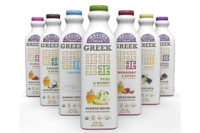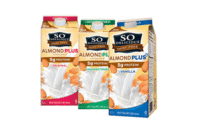As consumers look to fuel their bodies with healthy products, the consumer packaged goods (CPG) market is seeing dairy alternatives as a segment that could fulfill their demands. In its April 2015 report titled “Dairy and Dairy Alternative Beverage Trends,” Packaged Facts estimates that U.S. retail for the category was $23.8 billion in 2014.
Although the dairy segment dominates the category with 80 percent market share, dairy alternatives steadily are gaining ground. The segment increased its market share from 14.5 percent in 2010 to 20 percent in 2014, the Rockville, Md.-based market research firm reports. This growth is projected to continue as Packaged Facts forecasts the category to reach $31.5 billion in 2019.
Industry analysts note that a number of different factors are contributing to the growth of dairy alternatives, including demographic changes throughout the United States. “The Hispanic and Asian-American populations, which have a higher incidence of lactose intolerance, are growing faster than the total U.S. population,” says Virginia Lee, senior beverage analyst for Chicago-based Euromonitor International.
The Packaged Facts report also notes the influence of Hispanic consumers. “As in other food and beverage areas, the influence of the expanding Hispanic population will lead to increased interest among the non-Hispanic population in Latin products and possible [merger and acquisition] activity as large companies look to acquire promising smaller makers of Hispanic dairy and dairy-alternative beverages,” the report states.
In addition to demographic shifts, dairy alternatives are hitting on health and wellness as well as animal protection trends. “There has also been growing interest in a vegan diet to support animal rights and to protect the environment,” Euromonitor’s Lee says. “Raising cows to produce milk requires the use of feed, which produces a lot of waste and emits methane. The fact that non-dairy milk alternatives are lower in fat than cow’s milk gave sales another boost as older consumers seek to reduce fat consumption to prevent and/or manage heart disease.”
Lauren Masotti, client manager of U.S. Beverages for New York-based Kantar Worldpanel, also notes that consumers' desire to experiment with different varieties could be a contributing factor. However, among the various dairy alternatives — soy, almond, coconut, rice, etc. — mainstream news about soy and whether it is the best alternative product for children and males is causing a shakeup in the dairy alternatives market.
However, Emily Balsamo, research analyst for Euromonitor, notes that soy milk still has a dedicated following. “Despite sharp declines and a strong backlash against its health claims and prevalence of genetic modification, soy milk will likely stick around due to its increasingly small, but loyal following,” she says.
‘Almond joy’
Although soy milk previously accounted for the largest market share among the dairy-alternative sub-segments, as the dairy-alternative segment became more mature, variants such as almond milk and coconut milk have gained share from soy, Kantar’s Masotti explains.
According to an IBISWorld January 2015 report titled, “Soy & Almond Milk Production in the US,” soy milk now accounts for 25 percent of the segment, while almond milk represents 65.5 percent. Rice milk accounts for 5 percent while coconut milk maintains 3 percent of the market share, the Los Angeles-based market research firm reports. Other represents the remaining 1.5 percent.
Euromonitor’s Lee says soy milk’s decline can be attributed to a handful of factors including taste, health concerns and calories. “Consumers have been switching from soy milk to almond milk because they consider almond milk to taste better and enjoy the lower-calorie content of almond milk compared with soy milk,” she explains.
Packaged Facts notes that the growth of almond milk currently is the biggest market trend — a 40 percent increase in dollar sales from 2013 to 2014 — for the dairy alternatives segment. Almond milk also is gaining traction in other beverage categories. For example, Northfield, Ill.-based Kraft Foods Group launched Gevalia Kaffee Iced Coffee with Almond Milk in three flavors, Mocha, Vanilla and Caramel. The ready-to-drink (RTD) iced coffees are made with 100 percent Arabica coffee and almond milk and contain 6 grams of protein in each 8-ounce serving.
Kantar’s Masotti anticipates that this ingredient trend will continue for almond milk as well as other dairy drinks and dairy alternatives. “Dairy drinks/alternatives will see an increase in occasions used as an ingredient as ready-to-drink smoothies, and ready-to-drink coffees and lattes are growing in retail, and are often mixed with milk or non-dairy alternatives,” she says.
Growing options
Beyond almond milk, other plant-based dairy alternatives are gaining steam. The Packaged Facts report noted that coconut milk dollar sales were up double-digits from 2013 to 2014.
IBISWorld’s report credits the rise in awareness of coconut water as a sports drink substitute as one of the reasons for coconut milk’s growth. However, the market research firm says that coconut milk does have its share of challenges. “Repeat purchases are weak in this segment, partly due to the flavor, which is not as universally appealing as that of almond milk,” it states. “Rising costs for coconut milk producers have also been partially passed on to consumers, which has reduced demand.”
In addition to coconut milk, cashew, hemp and hazelnut milks are growing, but still remain very small, Kantar’s Masotti notes. Although they account for a small portion of the market, these non-dairy drinks are meeting a number of consumer trends.
“These beverages play into many of the growing needs sought after by the average consumer,” Masotti says. “These include healthier choices, nutrition, indulgent treats and energy. We refer to this as a New Age Nutrition as consumers seek a multitude of traditional needs from newer niche players.”
Broomfield, Colo.-based White Wave Foods sees the potential of these smaller sub-segments. Under its Silk brand, the company released Cashewmilk to its lineup of plant-based dairy alternative offerings. Silk’s Cashewmilk is available in four varieties: Silk Original Cashewmilk, Silk Unsweetened Cashewmilk, Silk Chocolate Cashewmilk and Silk Vanilla Cashewmilk. The cashew-based beverages are free of cholesterol, lactose, dairy, soy and gluten. They also are verified by The Non-GMO Project.
The Packaged Facts report notes that combinations of various dairy alternatives could help the growth of the segment. “Processors are also offering blends of two or more plant-based ingredients and flavors,” it states. “Almond-coconut combinations are a basic while more ambitious mixes are being launched with ingredients such as chia, quinoa and hazelnut added to coconut, almond and rice drinks.”
These ambitious products also are fueling the development of limited-time offerings. “A leading new product trend in dairy and dairy alternative beverages is the increasing use of seasonal and limited-edition flavors to attract consumers,” Packaged Facts reports. “Colorful packaging and catchy names are a key component of the trend. The development of more flavored varieties has been among the leading product strategies marketers have been employing to boost sales.”
The market research firm adds that a January 2015 consumer online survey found that nearly 80 percent of respondents indicated that flavor variety is important to their purchase decision.
For example, Morton Grove, Ill.-based Lifeway Foods Inc. announced in September that the success of its new, lowfat Watermelon Kefir, introduced in June, has prompted a decision to rotate seasonal flavors on an ongoing basis throughout the year.
Watermelon Kefir, the company’s first summer flavor, generated the strongest sales of any limited-edition kefir in Lifeway’s history, according to the company.
“Our Watermelon Kefir is the fourth seasonal flavor we have introduced since 2009,” said Lifeway Chief Executive Officer Julie Smolyansky in a statement. “It practically flew off the shelves because it was clearly a product that would be available for a limited time only and shoppers wanted to grab it before it disappeared. That convinced us to expand our seasonal strategy to ensure that there is always a special, limited-run flavor for shoppers to buy. It’s a way to vary the menu for regular kefir drinkers, attract new customers by offering unusual flavor profiles and continue to build our footprint in the market.”
The company also brought back Pumpkin Spice and Eggnog in September and November, respectively. In December, it will bring back Cranberry Créme Brulee. A new spring flavor also is in development and scheduled to debut in March, it reports. In 2016, the company will re-release its Birthday Cake flavor in honor of Lifeway’s 30th anniversary.








